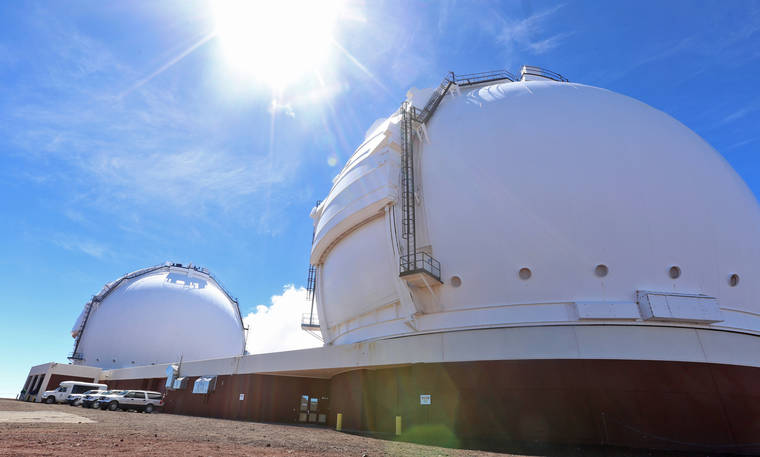Even with access to the summit restored for astronomers, some observatories on Maunakea will not be able to resume work for some time.
“It’s not like we can just walk in, flip a switch and be back on sky,” said Grant Hill, technical operations manager for W. M. Keck Observatory.
Modern observatories like Keck, Hill said, are more than just a telescope and a dome, but require a wide array of supporting infrastructure for the facility to function, including pumps, compressors, hydraulics, cooling systems and more. All of those systems have been in a state of hibernation, Hill said, and need to be restarted and tested before full operations can resume.
About 50% of Keck’s instruments are unusable at present, Hill said, largely because they have not been kept at their optimal temperatures, which are extremely cold. Just the act of cooling the instruments is a time-consuming process that can take days.
Hill said another instrument had been dismantled when observatory directors chose to pull all staff from the mountain in July, and will need to be reassembled when access resumes.
However, Hill said it is difficult to estimate a timeframe for how quickly Keck could be returned to operational capacity. Because the scheduled projects at the observatory have different needs, Keck will prioritize restarting different instruments depending on when access to the facility resumes, leading to different end dates.
Keck’s Chief of Operations Rich Matsuda reiterated that the limited access to the summit that had been allowed to observatory technicians was far from sufficient to resume even limited operations. Technicians were allowed access to the summit only in case of emergency; Keck had done so only three times since staff were removed from the summit.
Other telescopes are in similar straits. Michitoshi Yoshida, director of the Subaru Telescope on Maunakea, said it would likely take a full month before any night observations could begin, largely due to repair work required on the observatory dome.
Yoshida said observatory technicians have visited the summit five times since July 16, when all observatory staff were removed from the mountain, largely to do preparatory work for the dome repairs.
However, other engineering work, such as testing and reinstalling instruments will also be necessary after dome repairs are complete, Yoshida said.
Other observatories are more confident about their ability to return quickly to full operations.
Andrew Adamson, associate director of Gemini Observatory said Gemini would likely be able to reactivate shortly after a previously scheduled two-week maintenance shutdown period.
That shutdown period, Adamson said, occurs each year for invasive maintenance projects that require parts of the telescope and its instruments to be dismantled. This year, the primary mirror for the telescope wwas to be removed so it could be recoated, but Adamson said that would be postponed until next year in order to shorten the shutdown period.
“It’s an awkward calculation; if we leave it until next year, the mirror’s reflectivity will drop by about one percent, which we’ve accepted,” Adamson said.
Doug Simons, executive director of the Canada-France-Hawaii Telescope, said his observatory does not rely upon the same cooling systems as Keck, and could therefore be brought back online within about a day of resumed access.
Access to the summit will continue similarly to how it has for the last several weeks, a process wherein an observatory contacts the Office of Maunakea Management, which contacts law enforcement at the site, who discuss access with the protesters. However, Matsuda said that chain of communication is largely one-directional and the observatory does not know if a given vehicle will be allowed up until it reaches the access road.
“There’s a lot of coordination we have to go through,” Matsuda said.
Keck’s most recent trip to the summit took place last in early August, to address an alarm that had been triggered at the facility. It turned out that the alarm was caused by water condensation on a sensor, but there was no way to tell it was not something more serious, like a fire, without confirming it in person, Matsuda said.
Technicians and astronomers are required to drive to the access road along an unpaved path across lava rock, which is lined with parked vehicles, tents and pedestrians. Matsuda said traversing that path by night would be potentially unsafe, and so the path has now been lined with traffic cones and coated with cinder. That said, there remains no safe way to make a left turn onto the path from Daniel K. Inouye Highway because of the lack of a turn lane.
Because the unpaved path is not ideal for delicate instruments, larger vehicles or those transporting fragile supplies will be allowed to travel on the access road itself, although they must still skirt around the encamped protesters on the roadway, as one truck transporting liquid nitrogen was allowed last week.
Email Michael Brestovansky at mbrestovansky@hawaiitribune-herald.com.

